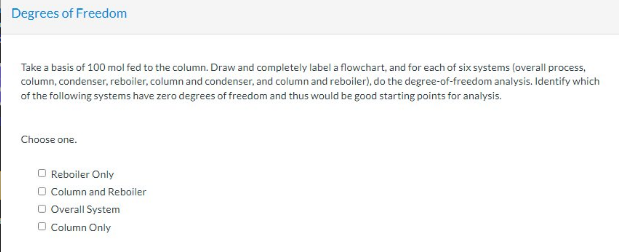Take a basis of 100 mol fed to the column. Draw and completely label a flowchart, and for each of six systems (overall process, column, condenser, reboiler, column and condenser, and column and reboiler), do the degree-of-freedom analysis. Identify which of the following systems have zero degrees of freedom and thus would be good starting points for analysis. Choose one. Reboiler Only Column and Reboiler Overall System O Column Only
Take a basis of 100 mol fed to the column. Draw and completely label a flowchart, and for each of six systems (overall process, column, condenser, reboiler, column and condenser, and column and reboiler), do the degree-of-freedom analysis. Identify which of the following systems have zero degrees of freedom and thus would be good starting points for analysis. Choose one. Reboiler Only Column and Reboiler Overall System O Column Only
Introduction to Chemical Engineering Thermodynamics
8th Edition
ISBN:9781259696527
Author:J.M. Smith Termodinamica en ingenieria quimica, Hendrick C Van Ness, Michael Abbott, Mark Swihart
Publisher:J.M. Smith Termodinamica en ingenieria quimica, Hendrick C Van Ness, Michael Abbott, Mark Swihart
Chapter1: Introduction
Section: Chapter Questions
Problem 1.1P
Related questions
Question

Transcribed Image Text:Degrees of Freedom
Take a basis of 100 mol fed to the column. Draw and completely label a flowchart, and for each of six systems (overall process,
column, condenser, reboiler, column and condenser, and column and reboiler), do the degree-of-freedom analysis. Identify which
of the following systems have zero degrees of freedom and thus would be good starting points for analysis.
Choose one.
Reboiler Only
O Column and Reboiler
□ Overall System
O Column Only
![Feed
100 mol
Xy (mol B/mol)
1-x, (mol T/mol)
Boilup
mol B(v/mol]
Bottoms product
REBOILER almol Bly/moll
Inside the column a liquid stream flows downward and a vapor stream rises. At each point in the column some of the liquid vaporizes
and some of the vapor condenses. The vapor leaving the top of the column, which contains 97.0 mole % benzene, is completely
condensed and split into two equal fractions: one is taken off as the overhead product stream, and the other (the reflux) is recycled to
the top of the column. The overhead product stream contains 92.2 % of the benzene fed to the column.
The liquid leaving the bottom of the column is fed to a partial reboiler in which 40.0 % of it is vaporized. The vapor generated in the
reboiler (the boilup) is recycled to become the rising vapor stream in the column, and the residual reboiler liquid is taken off as the
bottom product stream. The compositions of the streams leaving the reboiler are governed by the relation
YR/(1-YB)
= 2.25
xa/(1-x)
where yg and xg are the mole fractions of benzene in the vapor and liquid streams, respectively.
DISTILLATION
COLUMN](/v2/_next/image?url=https%3A%2F%2Fcontent.bartleby.com%2Fqna-images%2Fquestion%2Fd9c524e9-79a9-457c-8820-622a68640365%2F8ce4f9c8-c3cc-403a-8678-df40f165781e%2Febhgcss_processed.png&w=3840&q=75)
Transcribed Image Text:Feed
100 mol
Xy (mol B/mol)
1-x, (mol T/mol)
Boilup
mol B(v/mol]
Bottoms product
REBOILER almol Bly/moll
Inside the column a liquid stream flows downward and a vapor stream rises. At each point in the column some of the liquid vaporizes
and some of the vapor condenses. The vapor leaving the top of the column, which contains 97.0 mole % benzene, is completely
condensed and split into two equal fractions: one is taken off as the overhead product stream, and the other (the reflux) is recycled to
the top of the column. The overhead product stream contains 92.2 % of the benzene fed to the column.
The liquid leaving the bottom of the column is fed to a partial reboiler in which 40.0 % of it is vaporized. The vapor generated in the
reboiler (the boilup) is recycled to become the rising vapor stream in the column, and the residual reboiler liquid is taken off as the
bottom product stream. The compositions of the streams leaving the reboiler are governed by the relation
YR/(1-YB)
= 2.25
xa/(1-x)
where yg and xg are the mole fractions of benzene in the vapor and liquid streams, respectively.
DISTILLATION
COLUMN
Expert Solution
This question has been solved!
Explore an expertly crafted, step-by-step solution for a thorough understanding of key concepts.
This is a popular solution!
Trending now
This is a popular solution!
Step by step
Solved in 4 steps with 2 images

Recommended textbooks for you

Introduction to Chemical Engineering Thermodynami…
Chemical Engineering
ISBN:
9781259696527
Author:
J.M. Smith Termodinamica en ingenieria quimica, Hendrick C Van Ness, Michael Abbott, Mark Swihart
Publisher:
McGraw-Hill Education

Elementary Principles of Chemical Processes, Bind…
Chemical Engineering
ISBN:
9781118431221
Author:
Richard M. Felder, Ronald W. Rousseau, Lisa G. Bullard
Publisher:
WILEY

Elements of Chemical Reaction Engineering (5th Ed…
Chemical Engineering
ISBN:
9780133887518
Author:
H. Scott Fogler
Publisher:
Prentice Hall

Introduction to Chemical Engineering Thermodynami…
Chemical Engineering
ISBN:
9781259696527
Author:
J.M. Smith Termodinamica en ingenieria quimica, Hendrick C Van Ness, Michael Abbott, Mark Swihart
Publisher:
McGraw-Hill Education

Elementary Principles of Chemical Processes, Bind…
Chemical Engineering
ISBN:
9781118431221
Author:
Richard M. Felder, Ronald W. Rousseau, Lisa G. Bullard
Publisher:
WILEY

Elements of Chemical Reaction Engineering (5th Ed…
Chemical Engineering
ISBN:
9780133887518
Author:
H. Scott Fogler
Publisher:
Prentice Hall


Industrial Plastics: Theory and Applications
Chemical Engineering
ISBN:
9781285061238
Author:
Lokensgard, Erik
Publisher:
Delmar Cengage Learning

Unit Operations of Chemical Engineering
Chemical Engineering
ISBN:
9780072848236
Author:
Warren McCabe, Julian C. Smith, Peter Harriott
Publisher:
McGraw-Hill Companies, The